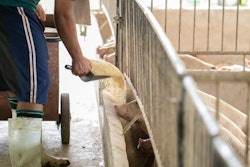
What you need to know about utilizing black soldier fly larvae (BSFL) ingredients in poultry, livestock diets
There has been a lot of buzz around the use of insect meal as an alternative protein source in poultry and livestock feed — with a particular commercial focus on black soldier flies (BSF).
Despite the type of processing method, dry or wet rendering, black soldier fly larvae (BSFL) create four primary products: whole dried larvae, which is used to create the two byproducts of production, BSFL oil and BSFL meal, and then frass, or the remaining biomass comprised of exoskeletons and excreta.
To address some of the pressing questions about the use of BSF in feed and to examine the ingredient’s potential, Enviroflight‘s president Liz Koutsos and InnovaFeed’s head of marketing and sales Chloé Phan Van Phi recently participated in the Feed Strategy webinar, “Challenges and opportunities for insect meal in animal feed.”
Here’s an abbreviated list of the things to know about BSFL ingredients in feed:
1. A sustainable, eco-friendly feed ingredient
Black soldier flies have a rapid life cycle, e.g., egg to harvestable size larva in less than 20 days.
“The entire lifecycle of this animal can take up to 40 or 50 days depending on the environmental conditions and the feedstock that they’re reared on,” Koutsos said. “So that the generational time and the opportunities to advance genetics and those types of processes is incredibly rapid as well.”
BSFL can also thrive on a variety of feedstocks, making them flexible and adaptable to regional and seasonal availability.
In the U.S., for example, larval-rearing feedstocks must be pre-approved.
“To be approved, they either must have an Association of American Feed Controls Officials (AAFCO) definition, meaning it’s gone through some safety studies and has been demonstrated to be safe or feeding to animals, or has generally recognized as safe status, or FDA’s GRAS status, which also requires safety studies,” she explained.
Currently, Enviroflight’s BSFL feed on DDGS, cookie meal and other organic materials from pre-consumer processing. However, alternative feedstock streams currently not approved for use, such as post-consumer food waste and animal waste/manure, may be of value down the line, but would require additional safety studies before and after it is fed.
Two added benefits to BSF: they are not considered an invasive species on any continent and do not carry zoonotic diseases.
“This enables us to ensure a healthy ecosystem not only for the animals that we are rearing, but for the people that grow them and for the environment that they’re reared in,” she noted.
2. Nutritional value
BSFL oil is high in lauric acid, a C-12 saturated fatty acid with demonstrated value-added, antimicrobial and antibacterial properties.
“Not only is [BSFL] an energy source, lauric acid can improve GI tract health and improve resistance and resilience to disease,” Koutsos said. “In case of the meal, these high protein meals can be used to really replace less sustainable protein sources. For most animals, we see application rates up to 20 to 25% inclusion of the diet — beyond which you do start to see somewhat of a fiber like effect because of the exoskeleton of the insect.”
Koutsos presented trials showing direct benefits to poultry and piglet health and FCR improvements during her talk.
In addition to the main four BSFL products, some companies are commercializing secondary BSFL products including chitin/chitosan, melanin and hydrolyzed proteins, further hydrolyzing protein rich meal to create a more digestible and available protein sources, she noted.
The nutritional quality of BSFL products is determined by the life cycle stage of the larva when it is harvested and the feedstocks it is fed, which directly impacts its performance and composition.
“As we create high value nutrition for other animal species, we need to be very cognizant of what the nutrient profiles of the larvae,” she said. “And we can dramatically influence the level of fat and protein, the fatty acid profile, the vitamin content and the mineral content of larvae depending on how we feed them.”
3. Regulatory status
In the U.S., BSFL ingredients have been approved for most animal diets for less than five years, but the remaining regulatory hurdles may be overcome very soon.
“To feed our ingredients, we have to demonstrate safety and efficacy of the product,” Koutsos said. “There are many studies being published and more coming out daily, demonstrating the safety and advocacy of BSFL-derived ingredients for a variety of animal species.”
Further expansion of BSFL ingredients in pet, poultry and swine diets will be under review at AAFCO’s next meeting on August 2.
| U.S. Regulatory Status of Black Soldier Fly Larvae (BSFL) Ingredients* | |||
| BSFL (whole, dried) | BSFL Meal | BSFL Oil | |
| Poultry | Approved | Approved | Under review |
| Swine | Approved | Approved | Approval in process |
| Aqua | Approved for finfish | Approved for finfish | Approved for finfish |
| Pet | Approval in process for adult dogs | Approval in process for adult dogs | Approval in process for adult dogs |
*Via FDA and AAFCO approval | Source: Enviroflight
“Many companies have put tremendous amount of time and effort into these regulatory dossiers, putting together the safety data,” she said. “This table probably represents 10 years’ worth of work, and obviously with more species still to be reviewed and approved.”
Koutsos and Phan Van Phi dug much deeper into the ways BSFL is processed and its potential as a major feed ingredient in the future during their presentations — much more than I can cover here. So if you missed the live webinar, I urge you to watch the archived recording.
To watch an on-demand recording of the “Challenges and opportunities for insect meal in animal feed” webinar, click here.

















